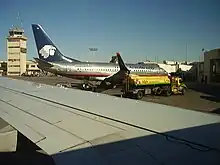Tijuana International Airport
General Abelardo L. Rodríguez International Airport (Spanish: Aeropuerto Internacional General Abelardo L. Rodríguez) or simply Tijuana International Airport (Spanish: Aeropuerto Internacional de Tijuana) (IATA: TIJ, ICAO: MMTJ), is an international airport three miles (4.8 km; 2.6 mi) northeast of Downtown Tijuana. It is the main International Airport in Tijuana, Baja California, Mexico, and serves the Metropolitan Area of San Diego-Tijuana. It is the fourth busiest in Mexico after Mexico City, Cancun, and Guadalajara airports, and Latin America's 13th-busiest airport. It handled 8,925,900 passengers in 2019, and 12,324,600 in 2022,[1] becoming the fifth airport in the country to transport more than ten million passengers in a year.[2] The airport can handle up to 10 million passengers per year and 360 flights per day.
General Abelardo L. Rodríguez International Airport Aeropuerto Internacional General Abelardo L. Rodríguez | |||||||||||||||
|---|---|---|---|---|---|---|---|---|---|---|---|---|---|---|---|
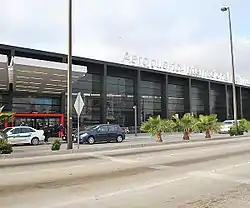 | |||||||||||||||
| Summary | |||||||||||||||
| Airport type | Public / military | ||||||||||||||
| Operator | Grupo Aeroportuario del Pacífico | ||||||||||||||
| Serves | Tijuana–San Diego | ||||||||||||||
| Location | Tijuana, Baja California (CBX terminal in Otay Mesa, San Diego, California) | ||||||||||||||
| Hub for | |||||||||||||||
| Focus city for | |||||||||||||||
| Elevation AMSL | 489 ft / 149 m | ||||||||||||||
| Coordinates | 32°32′27″N 116°58′12″W | ||||||||||||||
| Website | Aeropuerto Internacional de Tijuana | ||||||||||||||
| Map | |||||||||||||||
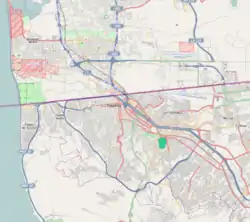 TIJ 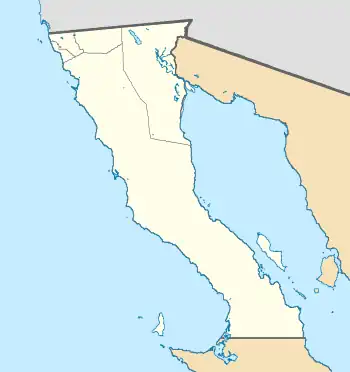 TIJ  TIJ | |||||||||||||||
| Runways | |||||||||||||||
| |||||||||||||||
| Statistics (2022) | |||||||||||||||
| |||||||||||||||
Source: Grupo Aeroportuario del Pacífico | |||||||||||||||
The airport is located in the city's Otay Centenario borough, immediately south of the US border. With the opening of the Cross Border Xpress bridge and terminal on December 9, 2015,[3] Tijuana Airport features one of the only three cross-border passenger terminals in the world (after Geneva and Basel-Mulhouse). The airport can be accessed directly from the U.S.; passengers can walk across a bridge spanning the U.S.-Mexico border between a terminal on the U.S. side and the main facility on the Mexican side.[4][5] It handled 4,186,500 passengers in 2023, which accounts for roughly one-third of all passenger movements at Tijuana Airport.[6]
The airport serves as a hub for Volaris, which is the only airline operating at both concourses and a focus city for Viva Aerobus. It used to be the largest and main hub for Avolar, and a focus city for the defunct Aero California, Aerolíneas Internacionales, Líneas Aéreas Azteca, and ALMA de Mexico. In terms of domestic destinations (totalling 41 cities), it is the best-connected airport after Mexico City-Benito Juarez.[7]
It is operated by Grupo Aeroportuario del Pacífico, a holding group that controls 12 international airports in central and northern Mexico. Tijuana Airport is Mexico's second-northernmost airport after Mexicali International Airport.
History


The Tijuana airport opened as the "Aeropuerto Federal de Tijuana" on May 1, 1951,[8] replacing Tijuana's former airport, then located on today's Aguacaliente Boulevard. The airport's runway had an orientation of 10/28 and was 2 kilometers in length (6,500 feet) and the first terminal was built on the southwest part of the airport, facing the current terminal built in 1970. The airport was named after General Abelardo L. Rodríguez, Governor of Baja California, and late President of Mexico.
In 1954, Mexicana de Aviacion began direct Tijuana-Mexico City flights. The airport was incorporated to ASA in 1965. Under President Gustavo Diaz Ordaz, a National Plan of Airports was initiated and headed by Gilberto Valenzuela Ezquerro, Secretary of Public Works (Secretario de Obras Publicas).[9] As more people arrived and settled in Tijuana in the 1960s, demand for flights increased.
Runway and facilities
At the inauguration of the Amistad Dam between Texas and Mexico in 1969, President Richard Nixon notified President Gustavo Díaz Ordaz of his intent to initiate Operation Intercept to stem the flow of narcotics between the U.S. and Mexico.[10] As political pressure rose between Washington and Mexico City, to minimize incursion into U.S. airspace, Gilberto Valenzuela Ezquerro, Secretary of Public Works and in charge of the Tijuana airport's expansion, re-oriented the runway from 10/28 to 09/27. The change in orientation impacted Tijuana's approach over Cerro San Isidro, a 2,600-foot (792.5-meter) land obstacle that increased the east approach glide slope above 3 degrees and prevented a full Instrument Landing System (ILS approach) on the 27 runway required during foul weather landings. Due to prevailing winds, the 27 runway is Tijuana's main approach pattern.
The construction of the new terminal and a 2.5-kilometer (1.6 mi) 09-27 runway to accommodate larger aircraft was finished in July 1970 and inaugurated on November 19, 1970, by then-President Gustavo Diaz Ordaz and Gilberto Valenzuela Ezquerro, Secretary of Public Works. The total cost for the improvements in 1970 was $108,487,000 Pesos ($8,678,960 U.S. dollars).[9] The original terminal was then assigned as an air base for the Mexican Armed Forces, and it is now known as the aeropuerto viejo, or old airport. The terminal, however, is seldom referred as Terminal 1, with Main Terminal being referred as Terminal 2.
In 1983, Tijuana became Mexico's fastest growing city, to meet increased airport demand; both terminal and parking areas were expanded. In 1987, air traffic suffered a sharp decline due to the suspension of service by Aeromexico. With the restructuring of Aeromexico in 1988, service and air traffic increased causing delays in service. Terminal space and parking for passengers became inadequate. To meet airport demand, Mexico issued its first two 10 year private sector airport "co-investments" to expand both the departure lounges and parking areas. Construction of both was completed in 1991.[11]
Privatization
Mexico's airport privatization program was initiated on December 22, 1995, when the Secretariat of Communications and Transportation (Secretaria de Comunicaciones y Transporte) published the "Ley de Aeropuertos" (Airport Law). The Tijuana airport became part of the Pacific Airport Group (Grupo Aeroportuario del Pacífico) consisting of 12 airports and headquartered in Guadalajara. In 1999, a consortium consisting of the Spanish investors Unión Fenosa, Dragados, and Aeropuertos Españoles y Navegación Aérea (AENA), together with the Mexican strategic investor Grupo Empresarial Ángeles, collectively known as Aeropuertos Mexicanos del Pacifico, S.A. de C.V. (AMP), won the Pacific 12 airport package.
Expansion
As part of the airport privatization concession, the airport terminal was expanded and renovated in 2002, when the extension of concourse A and B was built, allowing the terminal to double its capacity. Several taxiways were also expanded to allow the operations of larger aircraft such as the Boeing 747. Nevertheless, as the airport has become one of the most important hubs and gateways in the country, there is a plan of a new terminal, which could house the operations of the major airline at the airport: Aeroméxico (including Aeroméxico Connect). As of today, both of the concourses have been expanded and remodeled, including the progressive introduction of glass-jetways replacing the old ones. From 2011 to 2012, the airport's Terminal 1 underwent major renovations in Concourse A and B, including new customs and international arrivals facilities, construction of a new bus terminal, and other exterior renovations. In December 2015 the Cross Border Xpress (CBX) cross-border bridge and passenger terminal on the U.S. side opened.
In 2022, a new terminal building, named the "Nuevo Edificio Procesador" (New Processing Building), has opened. It consist of additional check-in counters, security lanes, boarding gates, and immigration facilities. The new terminal will allow for international flights, with targeted flight service to Asia and South America.[12] It also allows direct access to the United States from international arrivals via Cross Border Xpress, an increased width for air bridges, a new waiting room, and an expanded arrivals and documentation hall for international flights. In addition, there are plans for a hotel, an office facility, and a bus terminal.[13] Construction lasted from 2018 to 2022.
International service
From 2006 until September 2014, Aeroméxico operated three weekly flights to Tokyo-Narita, but in September 2014 they were transferred to Monterrey instead.[14] Aeroméxico resumed services to Shanghai on March 26, 2010, after the airline halted service 11 months earlier due to the 2009 flu pandemic.[15] The airline temporarily suspended service to Shanghai again from September 4, 2011, to January 10, 2012.
In 2019, the cancellation of the Mexico City-Tijuana-Shanghai route was announced, making Hainan's service to Beijing the only remaining international flight from the airport. International service ended in early 2020 (due to the COVID-19 pandemic) after Hainan announced the cessation of all flights to Mexico. International service will resume on February 15, 2024, when American Eagle begins operating flights to Phoenix, Arizona.[16]

Cross Border Xpress ("CBX", Terminal 2)

The project consists of a second terminal, located on U.S. soil adjacent to the border, and an international bridge. This building serves as a check-in and processing facility for departing passengers only, with no gates or arrival facilities (thus functionally resembling Hong Kong International Airport Terminal 2), but with its own parking and customs offices, that links passengers to gates at Terminal 1 via a 390-foot (119 m) bridge across the border.[17] The structural scheme allows greater access to flights out of Tijuana Airport for both domestic and international air carriers.[18]
The project had an initial estimated cost of $78 million US and a final completion cost of $120 million US, funded by Mexican and U.S. private investors and Grupo Aeroportuario del Pacífico.[17][19] Building E of Tijuana's Terminal 1 underwent restructuring, to support the new bridge own structure on Mexican soil. The initial design was the work of Ralph Nieders[20] who first introduced the concept of a cross-border passenger terminal in Mexico City to Mexicana de Aviación in 1989, to the San Diego Association of Governments in 1990 and in 2002, to the Bush-Fox Presidential Commission, Partnership for Prosperity, in Washington D.C. The design of the joint binational Terminal 2 building is the work of late Mexican architect Ricardo Legorreta.
Location



Runway 09/27 runs east–west approximately 300 meters south of the U.S.-Mexico border. The approach to the runway is either from the east (normally) or from the west (when Santa Ana wind conditions exist).
Brown Field Municipal Airport (SDM/KSDM) in San Diego, California lies just over one nautical mile (1.9 kilometres; 1.2 miles) north of TIJ, with a similar runway length and orientation. SDM is a general aviation field not set up for scheduled passenger service. Both SDM and TIJ are designated ports of entry for their respective countries.
Facilities
The airport consists of a single runway, a parallel taxiway, and a 23 gate main terminal with two concourses, a food court and a high-tech control tower, one of the tallest in Mexico. At the opposite side of the Main Terminal building there is another terminal and runway, the Old Airport Terminal, which houses military aviation, mostly performed by the Mexican Armed Forces; south of the adjacent runway (closed for commercial operations), there are 4 remote positions, mostly used by cargo airliners, linked by a shorter taxiway to the main runway. The airport is also used to a lesser extent for general aviation, housed at the General Aviation Building (GAB Terminal).
Main Terminal:
- Number of gates: 23
- Contact positions: 12
- Remote positions: 4
- Number of jetways: 10
- Lounges:
- VIP Room Tijuana (Main Terminal - Upper Level)
- Food court (Concourses A, B (airside), Main Corridor (landside))
- Customs & Immigration (International Arrivals are handled at Concourse B, departures at Concourse A)
- Passport & Nationality Control (domestic arrivals)
- Taxi & car rentals (Arrivals & Departures area)
- Bus Terminal (east of Main Terminal)
- Duty Free (Main corridor, Concourses A, B)
- Parking area (Building E)
New Processing Building:[12]
- Number of gates: 2
- Security screening lanes: 6
- Check-in counters: 52
- Immigration booths: 6
GAB Terminal:
- General aviation apron
 Gate AVIP room
Gate AVIP room View of concourse A
View of concourse A- Pilots lounge
- Passengers lounge
Old Airport Terminal
- Apron
- Contact positions: 2
- Remote positions: 4
- Helipads: 3
- Parking area
Cross Border Xpress ("CBX", Terminal 2):
- VIP room
- U.S. Customs and Border Protection
- Sports bar
- Coffee shop and sit-down restaurant
- Duty-free shop
- Taxi & car rental
- Parking
Airlines and destinations
Passenger



| Airlines | Destinations |
|---|---|
| Aeroméxico | Mexico City |
| American Eagle | Phoenix–Sky Harbor (begins February 15, 2024)[16] |
| Calafia Airlines | La Paz, Loreto, Puerto Peñasco, San José del Cabo Seasonal: Guadalajara |
| Mexicana de Aviación | Mexico City–AIFA (begins December 2, 2023)[21] |
| Viva Aerobus | Cancún, Culiacán, Guadalajara, León/Del Bajío, Mazatlán, Mexico City, Mexico City–AIFA, Monterrey, Morelia, Oaxaca, Puebla, Puerto Vallarta, Reynosa, San José del Cabo, Tulum (begins December 17, 2023)[22] |
| Volaris | Acapulco, Aguascalientes, Cancún, Chihuahua, Ciudad Juárez, Ciudad Obregón, Colima, Culiacán, Durango, Guadalajara, Hermosillo, Huatulco, Ixtapa/Zihuatanejo, La Paz, León/Del Bajío, Loreto, Los Mochis, Mazatlán, Mérida, Mexico City, Mexico City–AIFA, Monterrey, Morelia, Oaxaca, Puebla, Puerto Escondido, Puerto Vallarta, Querétaro, San José del Cabo, San Luis Potosí, Tapachula, Tepic, Toluca/Mexico City, Torreón/Gómez Palacio, Tuxtla Gutiérrez, Uruapan, Veracruz, Villahermosa, Zacatecas |
Cargo
Destinations map
| Destinations map |
|---|
 Tijuana Destinations from Tijuana International Airport Red = Year-round destination Blue = Future destination Black = Cargo destination Orange = Cargo and passenger destination Italic = Suspended destination |
Old airport terminal

The Old Airport Terminal (known by locals as Aeropuerto Viejo, old airport) is set for aviation of the Mexican Military and federal police forces. This military airbase belongs to the Northwestern Region of the Mexican Air Force. One cargo airline operates at the terminal.
Incoming flights of these armed forces agencies usually arrive from the Mexican Air Force Central Region, mostly from Mexico City International Airport or nearby airbases.
GAB Terminal
Note: The General Aviation Building (GAB Terminal) is used for general/non-commercial aviation or private jets. The General Aviation Building is designed to receive up to 120 persons per hour and it has all the services for the convenience of passengers during their private flights. It has a surface of 420 m2 (4,700 sq. ft.), where there are government offices, administrative offices, a pilots lounge, and passenger lounge. Two aviation schools are based at this terminal, along with one cargo airline operating there.
Statistics
Busiest routes
| Rank | City | Passengers | Ranking | Airline |
|---|---|---|---|---|
| 1 | Mexico City | 1,191,875 | Aeroméxico, VivaAerobús, Volaris | |
| 2 | Guadalajara | 1,068,321 | Aeroméxico, Magni, VivaAerobús, Volaris | |
| 3 | Culiacán | 474,739 | VivaAerobús, Volaris | |
| 4 | León | 364,503 | VivaAerobús, Volaris | |
| 5 | Morelia | 262,365 | VivaAerobús, Volaris | |
| 6 | Monterrey | 260,227 | VivaAerobús, Volaris | |
| 7 | San José del Cabo | 221,255 | Calafia Airlines, VivaAerobús, Volaris | |
| 8 | Puerto Vallarta | 204,546 | VivaAerobús, Volaris | |
| 9 | Cancún | 200,702 | VivaAerobús, Volaris | |
| 10 | Mazatlán | 172,825 | VivaAerobús, Volaris |
Ground transportation
Bus
The airport may be reached from Downtown Tijuana or Zona Rio by local bus. It costs $11.00 MXN (US$0.60).
Shuttle
Volaris provides a shuttle service from San Diego, California, United States to General Abelardo L. Rodríguez International Airport to allow San Diego residents to make connections within Mexico. People cannot board this shuttle at San Diego International Airport, but instead take a local bus from the Airport to the Amtrak Station, 1050 Kettner Blvd. on the corner of Broadway Ave, Downtown San Diego, CA 92101.[25] There is no equivalent shuttle from TIJ airport back to downtown San Diego as most people who connect between Tijuana Airport and San Diego pay to use the Cross Border Xpress, and then take private vehicles or Uber or taxis as there is no public transportation from CBX.
Taxi
Due to a prohibition by Mexican law, Mexican cities' public taxis may drop passengers at the airport, but cannot pick up passengers from the terminal. The airport thus offers transportation for passengers from the terminal to any point of the city on the SAAT Taxis (Servicio Aeroportuario de Autotransporte Terrestre, Spanish for Terrestrial Transport Airport Service, an airport government-leased taxi company). This and other authorized taxi carriers may be reached at the arrivals hall. This inflates taxi prices, forcing passengers to either pay them or walk outside the airport.
Gallery
 CBX from Mexican side
CBX from Mexican side CBX from US side
CBX from US side CBX from US side during daytime
CBX from US side during daytime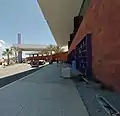 CBX view of the front
CBX view of the front Cross Border Express
Cross Border Express Cross Border Express
Cross Border Express CBX check in counters
CBX check in counters CBX ticket check in counters
CBX ticket check in counters CBX Gateway to Tijuana International Airport
CBX Gateway to Tijuana International Airport Control tower
Control tower Main corridor
Main corridor Waiting room
Waiting room Check-in counters
Check-in counters Check-in counters
Check-in counters VIP Lounge
VIP Lounge VIP Lounge
VIP Lounge VIP Lounge
VIP Lounge Main corridor
Main corridor Main corridor
Main corridor Main corridor
Main corridor Gates 1A-1C
Gates 1A-1C Airside
Airside Gates 1A-1C
Gates 1A-1C Gate A
Gate A Remote gates
Remote gates Planes
Planes
See also
References
- "GRUPO AEROPORTUARIO DEL PACIFICO REPORTS IN DECEMBER 2022" (PDF).
- "GAP Traffic Report 2022" (PDF). Grupo Aeroportuario del Pacífico. January 2023. Retrieved January 30, 2023.
- "Pedestrian bridge opens", Los Angeles Times, December 9, 2015
- Dibble, Sandra (21 November 2015). "Cross-border airport bridge opens next month". Archived from the original on 2015-11-25. Retrieved 2015-11-24.
- ""California Newest Airport Terminal Extends to Mexico, By ELLIOT SPAGAT, 'ASSOCIATED PRESS,' SAN DIEGO — Dec 7, 2015, 10:31 AM ET". ABC News. Archived from the original on December 7, 2015. Retrieved December 7, 2015.
- "GRUPO AEROPORTUARIO DEL PACIFICO REPORTS IN DECEMBER 2022" (PDF).
- "Tijuana: Bien conectada". Archived from the original on 2014-11-29. Retrieved 2014-11-24.
- AENA (July 2000). Plan Maestro del Aeropuerto de Tijuana. Grupo Aeroportuario del Pacífico. p. 1.4.
- Lopez, Fermin (September 30, 1970). Secretaria de Obras Publicas- Memoria de labores 1964-1970. Mexico City, Mexico: Compania Impressora y Lito Grafica Juventud, S.A. de C.V. pp. 186–215.
- Doyle, Kate. "Operation Intercept The perils of unilateralism". The National Security Archive. Retrieved 12 June 2016.
- Steve Casteneda-Ralph Nieders, co-authors (October 20, 1998). Crossborder Air Passenger Terminal Facility Phase 1 Report October, 1998 (PDF). South County Economic Development Council. p. 5. Retrieved August 12, 2015.
- Kuan, Albert (18 May 2022). "Tijuana International Airport Unveils New Transit Facility for Prospective Long-Haul Flights". Airline Geeks. Airline Geeks, LLC. Retrieved 20 May 2022.
- "New Terminal Building at Tijuana Airport". Estudio Lamena Arquitectos. Estudio Lamena S.L.P. Retrieved 2 November 2021.
- "Volará Aeroméxico de Monterrey a Tokio". www.milenio.com. Archived from the original on 2014-08-26. Retrieved 2014-08-22.
- "Tijuana-Shanghai flights to resume | UTSanDiego.com". Signonsandiego.com. 2010-01-12. Retrieved 2012-09-02.
- "American Airlines to offer two new destinations from Sky Harbor beginning in February". 12News. July 2023. Retrieved July 26, 2023.
- Marosi, Richard (December 9, 2015). "$120-million bridge lets travelers walk from San Diego to Tijuana's airport". Los Angeles Times. Retrieved 10 December 2015.
- "San Diego and Tijuana to Share an Airport". Slate. November 19, 2013.
- "Cross-border airport bridge to link Tijuana with San Diego". San Diego Union Tribune. September 5, 2013. Archived from the original on June 26, 2015. Retrieved November 21, 2013.
- Millman, Joel (August 1, 2001). "San Diego Looks South to Tijuana For New Airport Across Border". Wall Street Journal. Retrieved 23 December 2015.
- "These Are Our Destinations". Mexicana (in Spanish). October 2022. Retrieved October 4, 2023.
- "Viva Aerobus announces new routes to Tulum". EnElAire (in Spanish). August 2023. Retrieved August 25, 2023.
- Valadez, Roberto (1 September 2022). "Con AeroUnion, inicia operación de terminal de carga en aeropuerto de Santa Lucía". Milenio (in Spanish). Grupo Milenio. Retrieved 21 December 2022.
- "Estadística operacional por origen-destino / Traffic Statistics by City Pairs" (in Spanish). Agencia Federal de Aviación Civil. January 2023. Retrieved January 26, 2023.
- "Shuttle Tijuana/San Diego "
External links
- Tijuana International Airport
- Current weather at MMTJ from NOAA
- [http://www.aeropuertosgap.com.mx/index.php?lang=eng Grupo Aeroportuario del Pacífico - company that operates the airport.
- General Abelardo L. Rodríguez International Airport at Google Maps
- Off-Airport Parking and Ground Transportation
